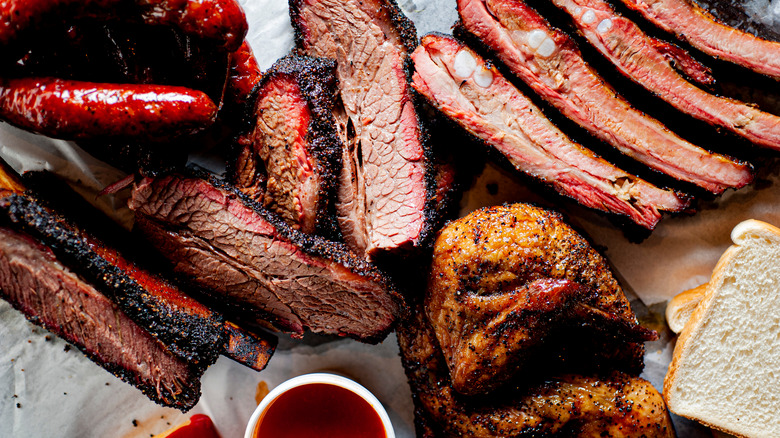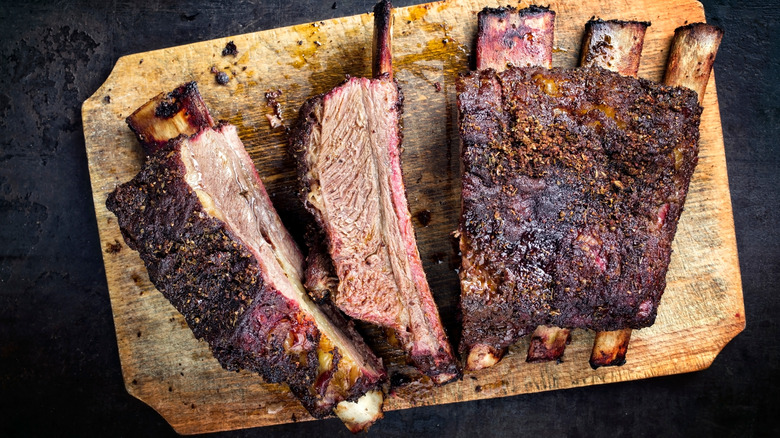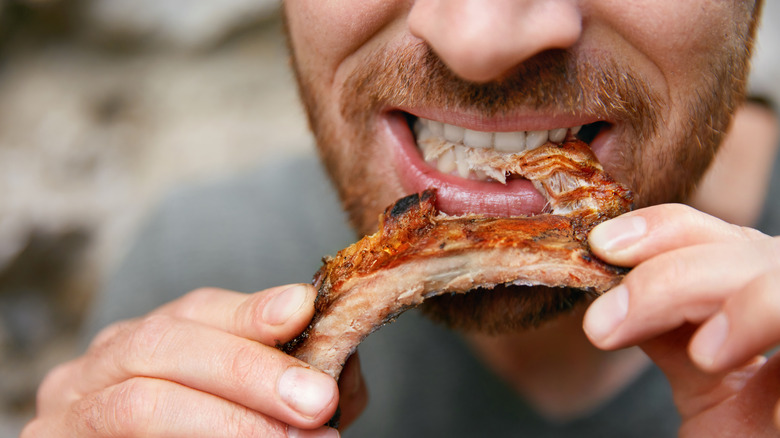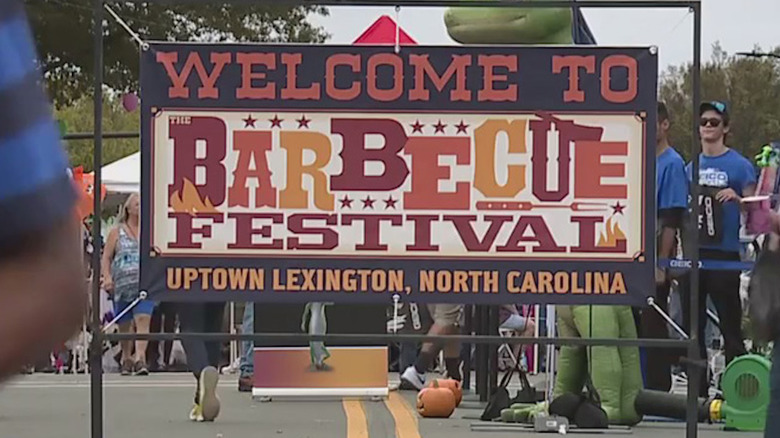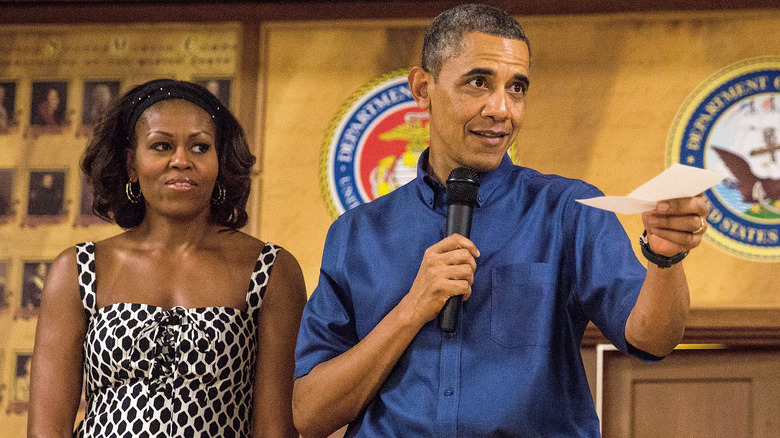The Untold Truth Of Barbecue
Steak. Ribs. Chicken. Pulled pork. Brisket. Is your mouth watering yet? If you've ever craved barbecue, you understand the temptation to chow down on some of the most tender meats you'll ever have. In addition to the juicy, fall-off-the-bone provisions, barbecue also involves an array of savory sides, including corn on the cob, cornbread, potato salad, macaroni and cheese, baked beans, coleslaw, and more.
Whether you consider barbecue a fun summertime backyard gathering or a type of cuisine that involves comfort-inducing, soul-filling ingredients (or both), it has definitely shaped our culture in many ways. The tradition of slowly cooking meat over indirect flame has become so widespread over the years that barbecue has become its own category of pop culture. More importantly, the cuisine appeals to just about every socioeconomic class, fits the bill for any occasion imaginable, and has never gone out of style.
Fire up those grills and get your napkins ready, folks! Let's learn a bit more about the mesmerizing art and succulent science of barbecue.
The name 'barbecue' has a mysterious origin
Where exactly did the word "barbecue" even come from? There are a handful of etymologies of the term, and modern linguists are still, to this day, having a challenging time deciphering the true origin, mainly because they're eerily similar. One theory relates to the French phrase barbe à queue, which translates to "beard to tail," likely a reference to the whole animal being cooked and eaten. A similar hypothesis exists for the term stemming from barba a cola, which is the same exact phrase in Spanish.
Perhaps the most widely accepted origin of the English word barbecue is that it derived from the ancient Haitian word barbacoa. Barbacoa refers to the structure of wooden sticks used to smoke animal meat over fire. However, 16th-century Spanish conquistadors also referred to the end result, the cooked meat, as barbacoa. Whatever the real source may be, the term is stickier than its signature sauce, and barbecue is certainly one of the most popular and diverse cuisines around the world. In the U.S., it seems that no matter where you travel, you'll stumble upon a unique barbecue style — from the iconic sauce recipes to the versatile cooking methods to the traditional fare included in a BBQ meal. There are four main styles of barbecue in America, even though several eatery menus across the nation claim there are even more. These four reigning regions are Carolina, Texas, Memphis, and Kansas City.
U.S. regions have their own BBQ twists
Carolina-style is believed to be the oldest form of American barbecue. Carolina barbecue traditionally involved pork that's served pulled, shredded, chopped, or sliced. Oak or hickory are the preferred woods to use during the smoking process. Carolina barbecue sauce has a characteristic vinegar or mustard base.
Texas-style barbecue involves beef over pork or poultry, which isn't too surprising considering the state's cattle population. And since the Lone Star State is so massive, it's inevitable that the barbecue styles will vary from border to border. However, the most distinguishable BBQ hails from Central Texas, where brisket is cooked low and slow over indirect heat. What about the sauce? No need for any extra texture or flavor, according to Texans (via Thrillist).
Memphis-style barbecue is most often made with pork, although some restaurants also use beef and chicken, relates Learn to BBQ. Barbecue in Bluff City is slow-cooked in a pit, offering an extra smoky flavor profile. There are also a couple important terms to know when ordering: "Dry" indicates the meat is slathered with a simple rub of salt and spices before cooking, then eaten without sauce. "Wet" meats are brushed with sauce before, during, and after cooking.
Kansas City barbecue is characterized by its use of a wide variety of slow-smoked meats, including pork, beef, chicken, turkey, mutton, and sometimes even fish. Burnt ends — the crusty tips of a brisket — are distinctive to that region. Kansas City barbecue sauce is tomato-based with a sweet, spicy, and tangy palate (via Learn to BBQ).
Two cities falsely claim to be the Barbecue Capital of America
Even outside the U.S., barbecue is a mega-popular indulgence. Korean barbecue, for instance, involves grilled pre-seasoned meats and banchan — umami side dishes such as kimchi and bibimbap.
When it comes to really outstanding good barbecue, a handful of cities probably come to mind. For example, Memphis, Tennessee and Kansas City, Missouri are two of the many epicenters of American barbecue. Both cities boast their own unique BBQ sauce recipes and are home to some pretty massive barbecue competitions. However, neither city holds the official rank of our nation's top barbecue metropolis.
In fact, the town of Lexington, North Carolina has been dubbed the "Barbecue Capital Of The World." Lexington hosts its annual Barbecue Festival, which has historically attracted more than 200,000 visitors every October. If you ever find yourself in Lexington in the fall, you can enjoy all the lip-smackin' barbecue you can eat, a wine garden, a family-friendly carnival, a car show, and tons more.
You can study the science of barbecue at Texas A&M University
Institutions of higher learning offer all manner of degree work in fields popular as well as obscure. But barbecue ... as a college major? Well, sort of. Texas A&M University has its own unique program called Texas Barbecue, which hosts events throughout the year, including festivals and summer camps that teach students the art and science of the beloved cuisine. Texas A&M also offers an innovative meat science program, which is within the Department of Animal Science in the College of Agriculture & Life Sciences. Available courses in the program include Fundamentals of Meat Curing, Food Safety, and Growth and Development of Meat Animals.
If you can't enroll in a university right now, there are plenty of online courses you can take to learn more about the wonderful world of barbecue, including one on MasterClass that's taught by James Beard Award winner and BBQ maestro Aaron Franklin.
U.S. Presidents surely love their barbecue
Among the list of the most American things ever, many of the United States Presidents were quite fond of barbecue. Even the earliest leaders of the nation loved a good slab of beef. George Washington allegedly made several references to his love for the saucy, meaty cuisine in his diary entries. Abraham Lincoln's parents hosted a barbecue as their wedding reception feast (per Washington Post). Prior to the American Civil War, Southerners consumed around five pounds of pork for every pound of beef, according to Smithsonian. In 1963, Lyndon B. Johnson hosted the inaugural Presidential Barbecue at the White House. The gourmet meal featured Texas-style barbecue ribs, coleslaw, baked beans, and beer. Yum!
As far as more recent Commanders in Chief, George W. Bush, a born and raised proud Texan, naturally considered barbecue his favorite comfort food, reports Business Insider. Former President Barack Obama is another barbecue fan and has been seen chowing down on the good stuff on multiple occasions, reports Eater. Back in 2014, he even was given permission by the starstruck patrons and owners of Franklin Barbecue in Austin to cut in line to get a taste of the finest brisket in the city — and then bought lunch for those patiently waiting behind him (via HuffPost).
